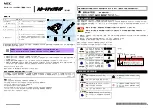
21020285 D
User’s Guide
Chapter 8 Details of Usage
Page 8 - 8
Tagged Queuing
Tagged
Queuing
The SCSI-2 and SCSI-3 specification provide a protocol for queuing commands
at the device level. The device is responsible for managing the order of the
commands, basing the order on message information from the initiator; the tag
message used by the initiator instructs the device where to place the command
in its queue. The initiator also uniquely numbers each command to identify it.
The RF3880 fully supports the tagged queuing protocol. This section describes
the RF3880 implementation of tagged queuing and how to use it.
How to Use
Tagged
Queuing
The RF3880 implementation of this SCSI-2 and SCSI-3 option is very simple
to use. These are the steps:
1. Enable Tagged Queuing
In order to use the SCSI-2 and SCSI-3 option of Tagged Queuing, you must be
sure that it is enabled on both the adapter and SCSI device.
Note
If your SCSI-2 or SCSI-
3 device is operating
with tagged queuing, the
Queue Full Count and
Maximum Queued fields
of the Extended Board
Statistics command
(16H) will contain
values. See Chapter 7.
A. Enabling on the RF3880
For the RF3880, tagged queuing is enabled for use with a device by
issuing a Unit Options or Extended Unit Options command with the
TAG bit of the Unit Flags field set before you issue any commands you
want to tag. The RF3880 will only send tagged messages to a device if
this flag has been set. This could be done during initialization.
B. Enabling on a SCSI Device
You may also need to enable tagged queuing on your SCSI device with
a Page 0AH Mode Select. See your vendor-supplied documentation for
more information. The RF3880 will not send an error to the Host if your
device rejects the queue tag message.
Summary of Contents for Rimfire 3880
Page 1: ...Rimfire 3880 SCSI Host Bus Adapter User s Guide Ciprico Inc Publication No 21020285 D...
Page 2: ......
Page 4: ...21020285 D User s Guide...
Page 25: ...2 H a r d w a r e E s s e n t i a l s...
Page 42: ...21020285 D User s Guide Chapter 2 Hardware Essentials Page 2 18 Descriptions of Port Usage...
Page 43: ...3 H a r d w a r e I n s t a l l a t i o n...
Page 59: ...4 C o m m a n d O p e r a t i o n...
Page 85: ...5 I n i t i a t o r M o d e P a s s t h r o u g h C o m m a n d s...
Page 103: ...6 T a r g e t M o d e P a s s t h r o u g h C o m m a n d s...
Page 125: ...7 B o a r d c o n t r o l C o m m a n d s...
Page 175: ...8 D e t a i l s o f U s a g e...
Page 193: ...A E r r o r C o d e s...
Page 201: ...B C a b l e s a n d C o n n e c t o r s...
Page 206: ...21020285 D User s Guide Appendix B Cables and Connectors Page B 6 VMEbus Connector Pinouts...
Page 207: ...C S p e c i f i c a t i o n s...
Page 210: ...21020285 D User s Guide Appendix C Specifications Page C 4 Specifications...
Page 211: ...D D e f a u l t s...
Page 216: ...21020285 D User s Guide Appendix D Defaults Page D 6 HardwareDefaults...
Page 217: ...E D e s i g n D i f f e r e n c e s...
Page 229: ......
Page 230: ...21020285 D...
















































